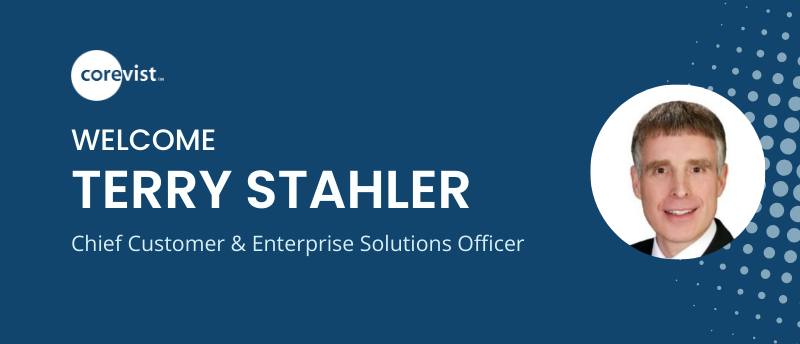Share
Author
George Anderson
Share
Our Clients Speak
What’s it like to live with Corevist’sSAP ecommerce solution, day in and day out? This question drives everything we do. It’s imperative that we keep asking our clients (and ourselves) this question. If we focus strictly on the technical/product aspect of our relationships with our clients, we risk losing sight of why Corevist exists in the first place—to make life easier for real people in B2B.
That’s why we communicate regularly with our clients through emails, meetings, and occasional surveys. Our most recent survey gave our clients a chance to tell us what life is really like with Corevist Commerce. Their answers surprised, delighted, and challenged us. Even better–we got a 57.9% response rate!
In this article, we’ll share our survey questions, and a few candid responses that really speak to our team. (We’ve anonymized those answers in this post.)
Question 1: What was the primary problem you were trying to solve before you chose Corevist Commerce?
Here are our top responses. They really underscore the story we hear time and again from our prospects:
- “Unsatisfactory performance and user experience with our old web shop.”
- “To bring SAP data to a web shop frontend in real time.”
- “Increasing employee efficiency by reducing the need for them to manually enter Sales Orders in our ERP system.”
- “Enabling customers to place online orders for our products. Eliminating phone and fax orders.”
- “Reducing call volume to CSRs for routine/mundane tasks like providing copies of shipping paperwork, copies of order confirmations, copies of invoices, inventory availability, and basic account status questions.”
- “Make it easier for our customers to do business with us.”
Question 2: What was the primary reason you chose Corevist Commerce?
Here are our top responses. They reinforce for us the value we bring to real people:
- “SaaS Solution very well integrated to SAP, with quick implementation.”
- “Ability to solve the problem, fitting to our landscape with SAP as ERP and Magento as shop platform.”
- “We chose Corevist because they were interested in understanding our business so that they were better prepared to help us use their technology to solve our problems.”
- “Easily connected to SAP and fast implementation.”
- “Ability to integrate with SAP.”
- “Our Marketing team wanted to use a Magento store front and we needed to connect our SAP ERP Backend to it.”
Question 3: In your mind, what sets Corevist apart from the competition? Please specify.
We asked this question in part because our market, like any IT market, is constantly changing. While we practice intense, ongoing research into our competition, we also want to hear from the real people who’ve evaluated us against the competition. Here are some of our favorite answers to this question:
- “The solution is easy and quick to implement, with a great integration with SAP (Business rules and data from SAP). The Corevist team provides great support and engagement on projects.”
- “Lean, agile, scrum-based approach. By providing a shopping cart solution that fits perfectly between SAP on the one side and Magento on the other side.”
- “The Corevist application is extremely performant and reliable, service is fast, and communication is very good.”
- “I really appreciate the active and ongoing relationship we have with them. They meet with us weekly to track and resolve support issues or enhancements. They also come to us with suggestions on how to improve conversion.”
- “Value for Cost – the solution is affordable and provides a lot of value for what we pay and implementation is fast.”
- “[Corevist CEO] Sam Bayer. Sam is visionary. I always learn something in every conversation I have with him. Sam makes us think about our business in different ways – seeing things from different viewpoints.”
Question 4: How satisfied have you been with the Corevist solution?
We asked this question on a sliding scale from least satisfied to most satisfied. It’s illustrative to look at the average responses in terms of NPS (net promoter score), which labels responses of 7-8 as “passives” and 9-10 as “promoters.”
We averaged 8.72 on this question.
An average response of 8.72 places us between passives and promoters, leaning toward promoters. In that sense, an 8.72% response puts us in great company (see next section). Still, it’s not enough.
We take full responsibility for the fact that we didn’t achieve an average of 9+ (“promoter”) regarding satisfaction. We aren’t perfect, and we did have a client whose response dragged our average down. The score that client gave us reflects the state of our production support process at the beginning of the year. Had we conducted this survey after May, when we greatly simplified our production support process, we believe our average response to this question would’ve been much higher.
Why? Because this client’s biggest complaint was our ability to serve them in production support and project development simultaneously. This client was evaluating us on the taste that was lingering due to unnecessary complexity in our process. If we were to send this survey out again, we’re certain that number would change.
In other words, we’re looking forward to the next client survey. We can’t wait to see what improvement this question gets now that we’ve significantly revised our production support process.
Question 5: How likely would you be to recommend Corevist to a colleague?
We asked this question on a sliding scale, too, and received an average of 9.28—well within the territory of 9-10, which counts as “promoters.”
That means, on average, our clients are full promoters of Corevist Commerce. They would recommend us to a colleague.
It’s easy to miss the significance of this. While we took it hard that we didn’t achieve an average of 9+ on question 4, both our response rates on these questions were incredibly high. As Wootric reports (using percentage rather than integer values for NPS), “The average American company scores less than +10% NPS.” Wootric goes on to list some of the top NPS leaders, including USAA Insurance at 80%, Apple Laptops at 76%, and Dillards at 75%.
In percentage terms, we sit comfortably in this list at 92.8% NPS.
Question 6: What could we be doing better?
For this question, we’ll highlight the most critical responses and what we’re doing to improve.
“It is meeting our needs, we just need to leverage it more as a Business.”
Our response: Wonderful! For a quick start on how to drive B2B ecommerce adoption, see this post on our blog.
“Having more attention for integrated testing in cases where multiple web shops are operational.”
What we’re doing: We’ve introduced automated testing for each of our clients. That way, we minimize the amount of manual intervention required to get new code deployed safely. Historically, our testing process wasn’t mircosite-specific. But we’ve since embarked on a project in which we are creating a suite of regression tests that are specific to each webshop/microsite. That way, we can test the requirements of each microsite in an automated fashion.
“I would appreciate if the layout of the frontend of the app could be more flexible and that we could easily align it with the Magento frontend (used as catalogue) in order to have a more seamless user experience.”
What we’re doing: We totally understand. We’re nearly done with a long-term project to better align the UI of the frontend app with the Magento catalog experience. This initiative will allow us to customize the UI of Corevist Commerce sync it key UI elements in the client’s Magento instance. As long as the client is using a Magento template from an approved list, the look and feel between Corevist and Magento will be almost identical.
“Not positioned well to provide production support in parallel with new development/enhancements. The out-of-the-box solution is your strength.”
What we’re doing: We take this criticism seriously. As our company has grown, the complexity of our clients’ SAP landscapes has grown, too. That’s why we’ve streamlined our production support process with a massive simplification, as mentioned earlier. For a detailed discussion, read the full article on our blog. At a high level, we’ve implemented two major changes to our support process to address this issue:
- We’ve implemented single-piece flow to ensure that fixes get into production fast. We recognize there’s no value to the fix until it’s in production. We want to get it into prod as quickly as possible.
- We’ve moved to a kanban-based pull system in support. Previously, a client relied on the same developer for both new development and production support. Our clients had to make King Solomon decisions between new features and fixes, because they had one assigned developer. Now we have developers assigned to development projects, and the entire support team is able to pull the top ticket from the list and get it into production. Now we deploy production fixes much faster because any team member can pick up a ticket and run with it.
Moving forward: FREE case study
Want more detail on how Corevist works in real life? Download this FREE case study on Mannington Mills. You’ll learn how Mannington grew web channel sales 150% with the addition of a full, B2C-style catalog through Corevist Commerce.
[want_more title=”Learn more” subtitle=”FREE Case study: 150% Sales Growth with Rich Content” description=”Learn how a leading flooring manufacturer more than doubled sales with a B2C-style catalog.” button_text=”Download Now” button_link=”/” button_class=”btn btn-primary mannington-ae” title2=”See it for yourself” subtitle2=”Talk to us” description2=”Curious what Corevist Commerce can do for you? Let us show you a personalized demo. You’ll see ecommerce with real-time SAP data.” button_text2=”Schedule Demo” button_link2=”https://www.corevist.com/demo/” button_class2=”demo-popup”]









